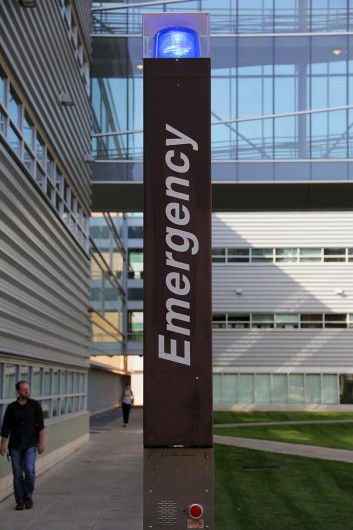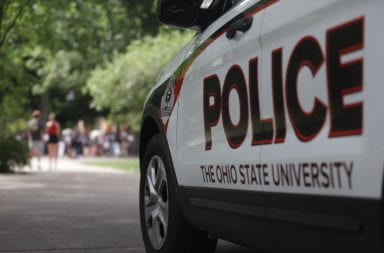
An emergency “blue light” phone located at 18th Avenue on OSU’s campus. Credit: Samantha Hollingshead / Photo Editor
At Ohio State, we students hear countless times about the importance of off-campus safety. Look through your emails and you’ll find a couple of notifications from the Columbus Division of Police about a robbery, break-in or an assault that occurred in the past couple of months. While these notifications raise our awareness, we never think these traumatic events could really happen to us… until they do.
On the morning of July 2, I was walking toward my apartment near the intersection of West 10th and Hunter Avenues. Before I could even realize what was happening, six men surrounded me, and I was suddenly shoved to the ground. There, outnumbered and alone, I was beaten and assaulted in the middle of the street. There was no one there to see what was happening, no one there to hear my screams and no one there to help me.
I did the only thing I could do in that instance: I ran. Bleeding and my clothes torn, I did not dare look back. It was adrenaline that took over me. Somehow escaping my attackers, I was taken to the hospital where I was treated for my injuries and where I filed a police report. The recovery was worse than actually being attacked, however. Physically, my wounds took weeks to heal. Mentally, I was frightened to walk through campus, had nightmares, trouble concentrating and was unable to return to a normal life for a very long time.
Although I have recovered now, I cannot help but worry for the safety of students on and off campus. For my assault, no public safety notice was issued to OSU students because it was not deemed a threat to the campus community. Since my attack this summer, eight recorded robberies have occurred throughout the campus community that have resulted in emailed public safety notices. Four of these attacks involved the victim being assaulted, and one involved a gun. This does not include the many possible incidences, such as mine, that the police have not made the community aware of.
While I have full faith and trust in both OSU and Columbus police, there are many ways to improve and strengthen our relationship with local law enforcement in order to effectively combat crime. After all, wouldn’t you want to know if your friend was assaulted off campus? It is important to point out that there is a very fine line between off and on campus, and that fine line means the difference between who has jurisdiction of crime-related events in the area. While University Police deal with matters on campus, an entirely different law-enforcing body, the Columbus Police, deals with crime just across the street. This fine line can potentially mean a difference in the way cases are dealt with and how information is released to the public. University Police are directly invested in and prioritize the safety of OSU students, whereas the Columbus Police deal with not only students in the off-campus vicinity but also the rest of the city.
This is not the first time someone has examined the Buckeye Alert system. In early April of this year, a kidnapping and aggravated robbery occurred on South Campus and no public safety notice was issued, raising some serious questions.
While it is understandable that actions are taken to prevent the spread of public panic, we as students should still have the opportunity to be made aware. How can law enforcement keep students safe and spread awareness of crimes without causing panic? The University of Chicago faced a comparable situation to OSU in regards to transparency of the activities of the local police department. University students rallied toward the creation of the Coalition for Equitable Policing and took steps to solve this issue by working with local residents, elected officials and stakeholders in addition to the police.
University of Chicago students succeeded in their campaign and in June, the University of Chicago Police Department began posting details regarding all crime incidents, including traffic stops, field contacts and arrests. The daily posts are available to University of Chicago students in one easy-to-access location through the University’s Safety and Security website. Additionally, emergency notifications are sent to students through their alert system. While OSU has a crime log on their website, it includes only incidents that students are already made aware of through the email alert system — incidents only police deem a threat to community. There is a lot that our school can learn from the University of Chicago in regards to how crime is dealt with and how information is made available to the public. It would mean great strides for Buckeyes if a daily crime log was more accessible to students in addition to our current safety notice system.
While we will be continuing to work with the local law enforcement in the future, I am happy to see some actions that are currently being taken in order to protect students. The Undergraduate Student Government is helping to bring a new safety app to students called Lifeline Response. This smartphone app allows the user to press and hold the phone screen if he or she is feeling unsafe. Removing the user’s finger after 15 seconds triggers an alert, with a follow-up call, and a notification to first responders of the GPS location. Users can also anonymously send reports of suspicious activity in the community, and then details of these events show up on a real-time map. This is a way other users can view areas of high risk. In addition to the app, USG is striving to make safety a key issue it deals with this year.
OSU also currently offers a program called Rape Aggression Defense (R.A.D.), which is a series of free self-defense classes for women in the community. In addition to R.A.D., any student can take free self-defense classes offered through the university. If you live off campus, you can also pick up a free window or door alarm from Student Life’s Neighborhood Services and Collaboration office. Buckeye Block Watch also provides a variety of tips and resources to be safe off campus. There is certainly more that OSU can do to combat crime, however.
I would certainly like to see more blue lights be placed off campus because there are very few in the area currently. In addition, increased use of cameras for security purposes in off-campus parking lots and street corners could help, but would definitely come with public backlash and liabilities. It might prevent the next car break-in or bike theft, however.
The issue of safety cannot be discussed without mentioning Student Safety Services, which has been criticized for the wait time for its escort services to arrive after dark. Students who would like to be escorted often have to wait several hours for services to arrive, forcing them to call well in advance. Those who realize they suddenly do not feel safe walking home after dark cannot depend on these services in their moment of need. It would be a huge benefit to students if the wait time for escort services was more efficient.
Looking at student safety as a whole, many wonder whether there is an increase in crime on and off campus. I definitely notice that I am hearing more crime-related events that have happened recently. Some have pointed out that this might be due to the gentrification of the Short North, which might have pushed crime toward the campus area.
For now, I urge students to be safe on and off campus. Watch out for one another, be that good friend who walks someone home, and trust your instincts. While OSU is a great school, not every place to live is perfect. It is important that we, as a university, work together in order to keep each other safe.
Sunder Sai
Second-year in neuroscience
Deputy Director of Health and Safety Committee, USG


